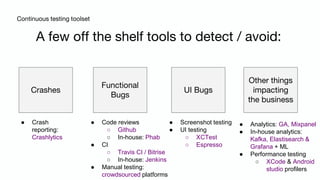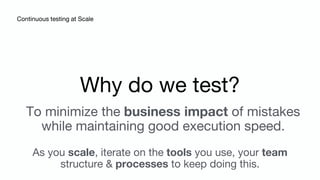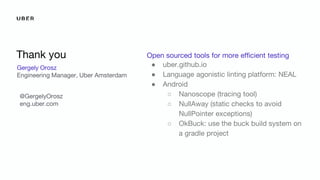Continuous testing at scale
- 1. Continuous Testing at Scale Gergely Orosz, Engineering Manager @GergelyOrosz 8 May 2018
- 2. ● Engineering manager @Uber, in Amsterdam ● 10+ years of software development (Skyscanner, Skype, JP Morgan alumni) ● Full-stack, iOS, Android, (Windows Phone) Introduction
- 3. War stories Trading systems Oil rig monitoring XBox One launch Uber apps rewrites Payment systems
- 4. A war story: Uber app rewrite
- 8. Iterating is part of the journey
- 9. Why do we test? We test to ship no bugs.
- 10. Bug-free code of substance But at what cost?
- 11. Why do we test? To minimize the business impact of mistakes while maintaining good execution speed.
- 12. We will cover testing of mobile apps. Still, a lot of the concepts apply across the stack.
- 13. Crashes Functional Bugs UI Bugs We test, so we can avoid:
- 14. … at Scale … at Uber … Tools & a Framework Continuous testing...
- 15. … at Scale … at Uber … Tools & a Framework Continuous testing...
- 16. Initial Team
- 17. Team Growth
- 18. ● 600+ cities, 65+ countries, 6 continents ● 10 engineering offices (4x US, Amsterdam, Denmark, 2x India, Sofia, Vilnius) ● 18,000+ people, of which 2,500+ engineers & 400+ mobile engineers Some Uber facts
- 19. Hundreds of mobile engineers? Request a ride Fare split Cash Uber for Business Credit card rewards points Promotions Promotions Safety Over 10 ways to pay Scheduled rides Drive with Uber Uber Eats, Freight, Bike, Rental... Experimentation 65+ countries, 600+ cities Performance Cash Instant payments Maps & navigation uberPOOL Driver incentives App health Developer tools Networking Feed cards Driver experience Driver recognition Airport pickup Uber Family Beacon Campaigns Fraud EATS app Driver app Freight app Restaurants app Other apps Fleet app
- 20. What can “at scale” mean? ● More functionality ● More users & regions, locales ● More code ● More engineers ● More engineering offices & locations ● More automated testing ● More apps
- 21. ● More functionality ● More users & regions, locales ● More code ● More engineers ● More engineering offices & locations ● More automated testing ● More apps What does “at scale” mean? ● More bugs ● Smaller/local bugs have bigger impact ● Longer build times ● Communication overhead ● Developer systems need to work 24/7 ● Longer time to run tests ● The same problems repeating Problems
- 22. What does “at scale” mean?
- 23. … at Scale … at Uber … Framework Continuous testing...
- 24. A few things I found different @Uber compared to my previous experience: ● No formal QA role, testing teams or dedicated DevOps team ● Dedicated team(s) owning testing infrastructure & developer tooling ● More formal planning process ● No staging systems: test tenancies instead ● Blameless postmortem culture Engineering culture
- 25. Continuous testing process @Uber Write code & land to master Pre-release testing Ship to users
- 26. Continuous testing process @Uber Write code & land to master Pre-release testing Ship to users
- 27. Continuous Integration arc diff Phabricator diff Local validations Code reviewers ● Commit message validation (e.g. test plan, revert plan) ● Linting Herald rules Rules like: ● “If certain files are touched, add {certain people} as reviewers ● If the files added contain a certain phrase, add a comment to the diff Build results Do a build with: ● Linting ● Unit tests ● Static code analysis Create a pull request
- 28. Herald rules
- 30. ● Our lint rules are extensive, evolved since the early years ● NEAL: our language agonistic linting platform (open sourced) Linting: a first class citizen
- 31. Continuous Integration arc diff Phabricator diff Local validations Lint, Build, Test Update the diff arc land “Merge to master” Code Repo Submit Queue Do a “full” build with: ● Linting ● Unit tests ● Static code analysis ● UI testsBuild Result Validation pass
- 32. Build speeds matter (even) more, as the team grows
- 33. Continuous testing process @Uber Write code & land to master Pre-release testing Ship to users
- 34. Continuous testing process @Uber Write code & land to master Pre-release testing Ship to users ● Local checks (linting) ● Continuous Integration (linting, unit tests, static analysis) ● Code review ● Safe merging to master (UI tests, SubmitQueue)
- 35. Continuous testing process @Uber Write code & land to master Pre-release testing Ship to users
- 36. Ready for production release. Merge code to master Release candidate ? master Build cut Automated tests Manual tests
- 39. Test tenancy Staging Production code (master) Test accounts Production accounts Production accounts Test accounts Test tenancy Production tenancy Staged rollout code (master) Staging & production systems Production system with test tenancy
- 40. Ready for production release. Merge code to master Release candidate master Build cut Automated tests Manual tests Dogfooding bugreports
- 41. Dogfooding
- 42. Dogfooding: sending bug reports Bug reporter tool Phabricator ticket Take screenshot Teams triage
- 43. Ready for production release. Merge code to master Release candidate master Build cut Automated tests Manual tests Dogfooding bugreports Crash reports
- 44. Ready for production release. Merge code to master Release candidate master Build cut Automated tests Manual tests Dogfooding bugreports Crash reports Localization ... Fix Hotfix
- 45. Build Train
- 46. Continuous testing process @Uber Write code & land to master Pre-release testing Ship to users ● Manual testing (sanity) ● Dogfooding ● Crash reports ● Build train
- 47. Continuous testing process @Uber Write code & land to master Pre-release testing Ship to users
- 48. Facts ● Bugs will be introduced that none of the previous tests catch ● With native apps ○ New builds can take days to ship due to the app store approval process ○ Users might not update their apps for a while. Conclusion ● Every change should be revertable, remotely. ● Let’s use backend-controlled feature flags Rolling out to production on mobile
- 49. Remote Bugfixing: Feature Flags
- 50. Rollout can be risky if the population is large & there is no monitoring. Staged rollout ● Control user exposure in early stages via a feature flag ● Monitor the impact on key business metrics at each stage Rolling out to production (not just) on mobile
- 51. Ready for production release. Staged rollout Monitor Rolled out Rolling out a new feature
- 52. Staged rollout monitoring for business impact: statistically significant differences
- 56. Continuous testing process @Uber Write code & land to master Pre-release testing Ship to users ● Staged rollout ● Monitoring & alerting ○ Crash reports ○ Business events ○ Performance
- 57. The mobile testing lifecycle Write code & land to master Pre-release testing Ship to users In production Build cut Release Staged rollout & monitoring Code & functional quality checks Functional & UX quality checks, hotfixes Are we done testing? Rolled out
- 58. Things will catch fire
- 59. The mobile testing lifecycle Write code & land to master Pre-release testing Ship to users In production Build cut Release Staged rollout & monitoring Code & functional quality checks Functional & UX quality checks, hotfixes Uh-oh... Monitor & triage issues/alerts
- 60. The mobile testing lifecycle Write code & land to master Pre-release testing Ship to users In production Build cut Release Staged rollout & monitoring Code & functional quality checks Functional & UX quality checks Outages Uh-oh... Monitor & triage issues/alerts
- 61. How can we make sure this does not happen again?
- 63. The goal of a postmortem Understand the root cause in order to take action to prevent the same issue from impacting customers again.
- 64. The 5 whys
- 65. The mobile testing lifecycle Write code & land to master Pre-release testing Ship to users In production Requirements & planning Product & engineering spec, with testing plan Outages & postmortems Uh-oh... “We did not do proper planning.” “We did not test this edge case.” “We did not have a test plan.”
- 66. The mobile testing lifecycle @Uber Write code & land to master Pre-release testing Ship to users In production Requirements & planning Staged rollout & monitoring Code level quality checks Functional & UX quality checks Outages & postmortems Monitor & triage issues/alerts Spec & testing plan Build cut Release Rolled out
- 67. … at Scale … at Uber … Tools & a Framework Continuous testing...
- 68. What worked for us, will not (exactly) work for you.
- 69. Why do we test? To minimize the business impact of mistakes while maintaining good execution speed.
- 70. Continuous testing: tools Crashes Functional Bugs UI Bugs We test, so we can avoid:A few tools to detect / avoid:
- 71. Continuous testing toolset Crashes Functional Bugs UI Bugs ● Crash reports ● Crash report alerting ● Code reviews ● Unit testing ● UI testing ● Manual testing ● Dogfooding ● Staged rollout ● Manual testing ● Dogfooding ● Screenshot testing A few tools to detect / avoid:
- 72. Continuous testing toolset Crashes Functional Bugs UI Bugs A few tools to detect / avoid: ● Crash reports ● Crash report alerting ● Code reviews ● Unit testing ● UI testing ● Manual testing ● Dogfooding ● Staged rollout ● Manual testing ● Dogfooding ● Screenshot testing Other things impacting the business ● Business monitoring & alerting ● Performance testing / monitoring ● (Tools that might work for you)
- 73. Continuous testing toolset Crashes Functional Bugs UI Bugs A few off the shelf tools to detect / avoid: ● Crash reporting: Crashlytics ● Code reviews ○ Github ○ In-house: Phab ● CI ○ Travis CI / Bitrise ○ In-house: Jenkins ● Manual testing: crowdsourced platforms ● Screenshot testing ● UI testing ○ XCTest ○ Espresso Other things impacting the business ● Analytics: GA, Mixpanel ● In-house analytics: Kafka, Elastisearch & Grafana + ML ● Performance testing ○ XCode & Android studio profilers
- 74. A framework to think about testing
- 75. The Continuous Testing Pyramid Manual tests UI tests Unit Tests Dog fooding Blameless postmortems Code reviews Continuous integration Monitor Alert Triage Things going wrong for customers Team owning testing infrastructure To make all of this scale: Improve processes & systems All engineers All engineers All engineers All teams All employees All teams
- 76. Continuous testing at Scale Why do we test? To minimize the business impact of mistakes while maintaining good execution speed. As you scale, iterate on the tools you use, your team structure & processes to keep doing this.
- 77. Gergely Orosz Engineering Manager, Uber Amsterdam Thank you Open sourced tools for more efficient testing ● uber.github.io ● Language agonistic linting platform: NEAL ● Android ○ Nanoscope (tracing tool) ○ NullAway (static checks to avoid NullPointer exceptions) ○ OkBuck: use the buck build system on a gradle project @GergelyOrosz eng.uber.com
- 78. Proprietary and confidential © 2018 Uber Technologies, Inc. All rights reserved. No part of this document may be reproduced or utilized in any form or by any means, electronic or mechanical, including photocopying, recording, or by any information storage or retrieval systems, without permission in writing from Uber. This document is intended only for the use of the individual or entity to whom it is addressed and contains information that is privileged, confidential or otherwise exempt from disclosure under applicable law. All recipients of this document are notified that the information contained herein includes proprietary and confidential information of Uber, and recipient may not make use of, disseminate, or in any way disclose this document or any of the enclosed information to any person other than employees of addressee to the extent necessary for consultations with authorized personnel of Uber.














































































